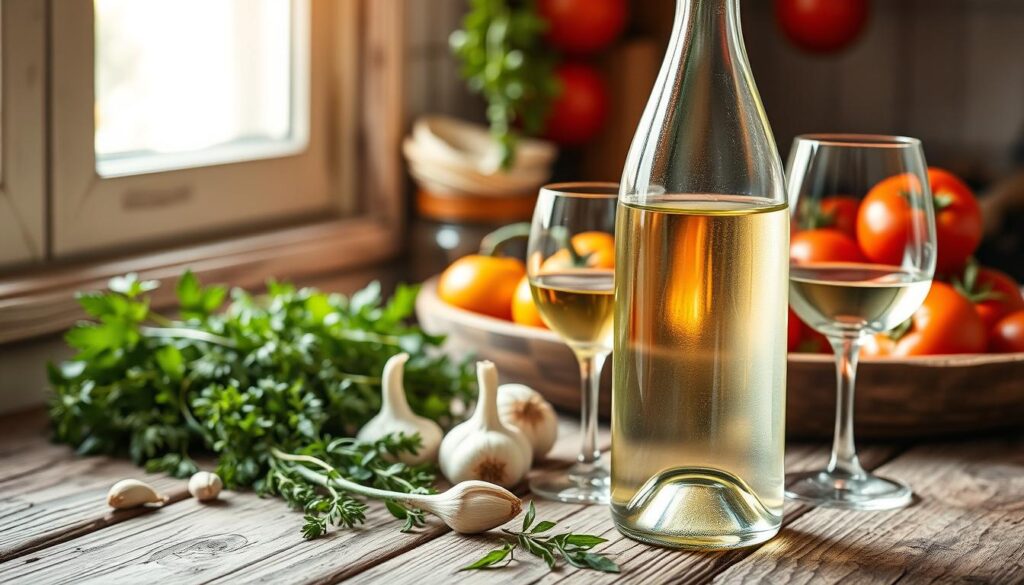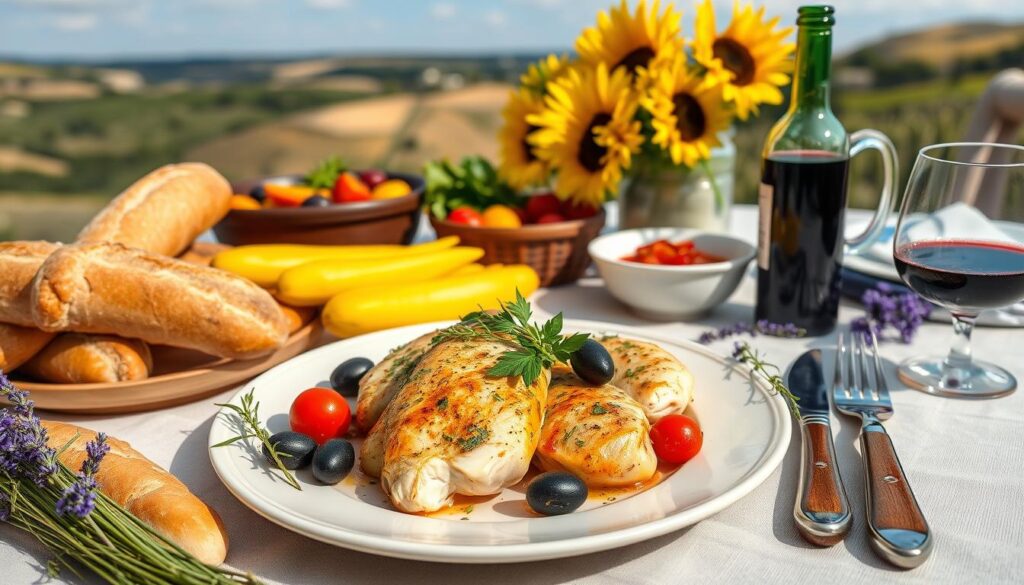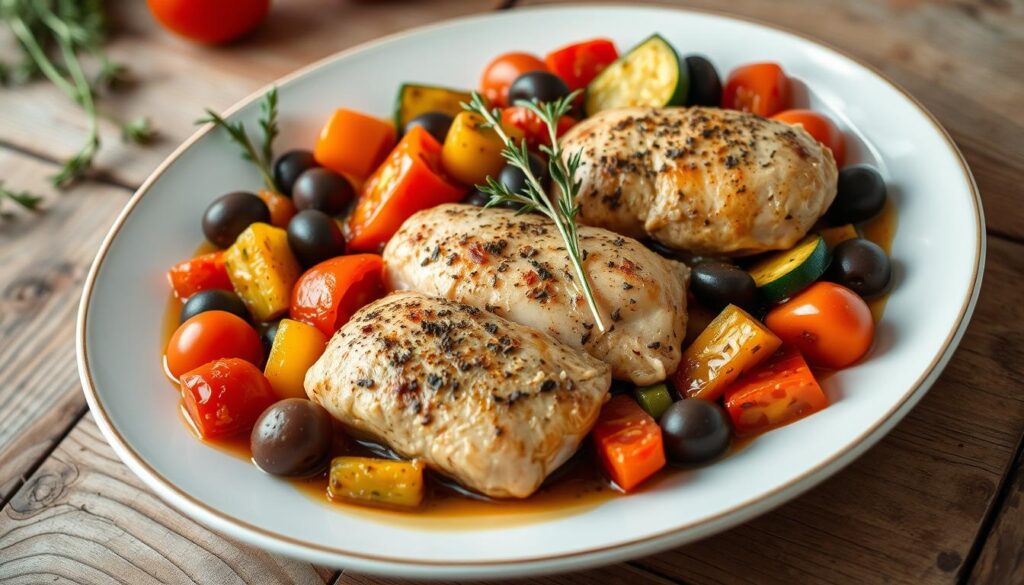Explore the rich culinary tradition of Provençal cooking through its beloved chicken dish. Chicken Provençal is a stunning example of French cuisine. It turns simple ingredients into an extraordinary meal. This classic recipe captures the essence of Mediterranean flavors with its vibrant blend of herbs, white wine, and fresh ingredients.
What makes chicken Provençal special is its ability to deliver remarkable taste with minimal effort. The dish typically takes just over an hour to prepare. Most of that time is spent on hands-off cooking. Your kitchen will fill with aromatic herbs and the enticing scent of braised chicken, promising a delightful dining experience.
Key Takeaways
- A quintessential French cuisine experience in one pot
- Combines Mediterranean ingredients with traditional braising techniques
- Perfect for home cooks seeking authentic flavor profiles
- Requires minimal active cooking time
- Versatile dish adaptable to various wine and ingredient variations
Introduction to the French Art of Provençal Cooking
Provençal cooking comes from southeastern France, where the sun shines bright. It’s a cooking style that turns simple ingredients into amazing dishes. These dishes show off the beauty of Provence’s rich land.
In Provence, French cooking is all about keeping things simple and using fresh, local foods. The area’s food is special because of its ingredients:
- Abundant use of olive oil
- Fresh herbs like thyme and rosemary
- Ripe tomatoes and garlic
- Local vegetables such as fennel and artichokes
“Provençal cooking is not just about food, it’s about capturing the spirit of the Mediterranean on a plate.” – Local Provence Chef
The cooking methods in Provençal cooking are slow. This lets flavors grow and ingredients stand out. Making a Chicken Provençal or a rustic ratatouille is all about layering flavors and respecting each ingredient.
Learning about Provençal cooking means you’ll see how simple ingredients can make unforgettable meals. It’s not just for locals; it inspires chefs and home cooks everywhere to enjoy fresh, well-made food.
The Heart of Provençal Cuisine
Dive into the vibrant world of mediterranean cuisine, where Provençal cooking captures the essence of southern French culinary traditions. The region’s unique flavor profile transforms simple ingredients into extraordinary dishes. These dishes tell a story of sun-drenched landscapes and rich cultural heritage.
Mediterranean Influences in Provençal Dishes
Provençal ingredients reflect the breathtaking Mediterranean coastal region. Your culinary journey will uncover a treasure trove of flavors. These flavors blend local traditions with coastal inspirations.
- Fresh herbs like thyme and rosemary
- Vibrant tomatoes and olives
- Garlic and shallots
- Extra virgin olive oil
Regional Ingredients and Flavors
French cooking techniques in Provence transform local ingredients into spectacular dishes. The warm climate allows for an abundance of fresh produce. Kalamata olives, cherry tomatoes, and fresh herb sprigs create a symphony of flavors.
“In Provence, every ingredient tells a story of sunshine and tradition.” – Local Chef
Traditional Cooking Methods
Mastering Provençal cooking means understanding slow-cooking and braising techniques. These methods allow flavors to develop deeply. This creates tender, rich dishes like Chicken Provençal.
- Slow simmering in olive oil
- Layering herbs and spices
- Combining stovetop and oven methods
- Using high-quality ingredients
By embracing these techniques, you’ll transform simple ingredients into a culinary masterpiece. This masterpiece captures the heart of Provençal cooking.
Essential Ingredients for Chicken Provençal
Creating authentic chicken recipes starts with understanding Provençal cuisine. The dish’s magic comes from its chosen ingredients. These ingredients turn simple chicken into a culinary masterpiece.
Your Chicken Provençal begins with top-notch ingredients. For the best olive oil recipes, pick extra-virgin olive oil. It’s the heart of Mediterranean cooking.
- Chicken Selection: 5-6 bone-in, skin-on chicken thighs
- Aromatics: 6 minced garlic cloves for garlic-infused dishes
- Vegetables:
- 4 shallots
- 1 1/2 cups cherry tomatoes
- 2 cans whole artichokes
- Flavor Enhancers:
- 12 oz Castelvetrano olives
- 2-3 sprigs fresh thyme
- 2 tablespoons chopped parsley
Wine is key in these chicken recipes. Choose a dry white wine like Sauvignon Blanc. Use about 3/4 cup for rich, complex flavors.
“The secret to great Provençal cooking is using fresh, local ingredients that tell a story of the region’s culinary heritage.” – Provence Cooking Traditions
Your sauce will blend 2 cups of chicken broth and 2 tablespoons of flour. This creates a luxurious coating for the chicken. It captures the essence of Mediterranean cuisine.
Choosing the Perfect Chicken Cuts
Choosing the right chicken cuts is key to a great Chicken Provençal. Knowing which parts of the chicken to use can make your dish delicious and authentic.
Why Chicken Thighs Reign Supreme
Chicken thighs are the top pick for Chicken Provençal. They offer several benefits:
- Higher fat content ensures juicy, tender meat
- Ability to withstand long cooking times without drying out
- Rich, deep flavor that complements Provençal herbs
Exploring Alternative Chicken Cuts
While chicken thighs are ideal, other options are available for this classic French dish:
| Chicken Cut | Cooking Performance | Flavor Profile |
|---|---|---|
| Drumsticks | Good for braising | Moderate flavor intensity |
| Leg Quarters | Excellent moisture retention | Rich, dark meat flavor |
| Chicken Breasts | Not recommended | Tends to dry out quickly |
The Critical Role of Skin-On Chicken
Using skin-on chicken is essential for Chicken Provençal. The skin is crucial for flavor and texture:
- Renders fat during cooking
- Creates a crispy, golden exterior
- Adds depth to the overall dish
“The secret to a perfect Chicken Provençal lies in choosing the right cut and keeping the skin on.” – French Culinary Experts
By picking the right chicken cuts, especially skin-on chicken thighs, you’ll have a memorable Provençal meal.
The Role of Herbs and Aromatics
Preparing herb-crusted chicken is all about the mix of provençal herbs and aromatic ingredients. These seasonings turn a simple dish into a French countryside masterpiece.
- Dried thyme
- Rosemary
- Oregano
- Marjoram
- Optional lavender
Martha Stewart’s recipe calls for a specific mix of these herbs. It ensures a balanced, fragrant seasoning. This blend adds a floral, aromatic touch, making your chicken dish stand out.
“Herbs are the soul of Provençal cooking, transforming ingredients into a sensory experience.” – French Culinary Tradition
Choose fresh garlic, shallots, and quality olive oil for your dish. These add depth and complexity. Add fresh thyme and rosemary during cooking to boost the flavor.
Pro tip: Toast your herbs in olive oil before adding chicken. This releases their oils and intensifies the flavor. Your kitchen will fill with a Mediterranean aroma, promising a tasty meal.
Wine Selection and Cooking Tips
Choosing the right white wine makes your Chicken Provençal special. French cooking uses wine to enhance flavors and techniques. This creates a dish full of rich, complex tastes.

Best White Wines for Braising
Choosing the right wine is key for Chicken Provençal. Dry white wines are best for a tasty sauce. Here are some great options:
- Chardonnay: Offers buttery undertones
- Sauvignon Blanc: Provides crisp acidity
- Pinot Grigio: Adds light, fresh notes
Wine Substitutions
Not everyone has white wine. But, you can use:
- Chicken stock with a splash of white wine vinegar
- Vermouth
- Dry sherry
Creating the Perfect Sauce
For a great Chicken Provençal sauce, reduce the cooking liquid. Simmer the wine, chicken fat, and vegetable juices. This makes the flavors stronger and the sauce richer.
“In French cooking, wine is not just an ingredient—it’s a storyteller of flavor.”
Pro tip: Reduce your sauce until it coats the back of a spoon. This gives you the true Provençal taste.
Step-by-Step Cooking Method
Making perfect one-pan meals needs precision and French cooking skills. Braising chicken turns simple ingredients into a masterpiece. Let’s go through the key steps to make authentic Chicken Provençal.
- 6 bone-in chicken thighs
- 1 cup cherry tomatoes
- 1 cup black or green olives
- 6 cloves minced garlic
- 2 shallots, quartered
The braising chicken method begins with seasoning. Dry your chicken and season well with salt and pepper. Heat 2 tablespoons of oil in a large oven-safe skillet until it shimmers.
“The secret to perfect Chicken Provençal lies in developing deep, rich flavors through careful browning.” – French Culinary Institute
Sear the chicken skin-side down for 5-7 minutes until golden. Flip and cook the other side for 3-4 minutes. Remove chicken and set aside.
| Ingredient | Quantity | Preparation |
|---|---|---|
| White Wine | 1 cup | Dry Chardonnay recommended |
| Fresh Herbs | 2 tbsp each | Rosemary and Thyme |
| Lemon | 1 quartered | Add brightness to the dish |
In the same skillet, add garlic, shallots, and herbs. Deglaze with white wine, scraping up browned bits. Return chicken to the pan, add tomatoes and olives. Put in a preheated 400°F oven and braise for 30-35 minutes until chicken is 165°F inside.
Your one-pan meal is now ready – a true celebration of French cooking. It turns simple ingredients into an extraordinary dining experience.
Mastering the Perfect Braise
Getting good at braising takes time and focus. When making Chicken Provençal, knowing the right cooking temperature is key. It helps make the chicken skin crispy and the dish amazing.
Braising is more than just cooking. It’s about paying attention to every detail. The right steps can turn your chicken into a true masterpiece.
Temperature Control Tips
Keeping the cooking temperature steady is vital for braising. Here are some tips:
- Preheat your oven to 400°F (200°C)
- Use an oven-safe thermometer to monitor heat
- Avoid opening the oven too often to keep the temperature stable
Achieving Crispy Chicken Skin
Getting the chicken skin crispy is the goal for Chicken Provençal. Here’s how to do it:
- Pat the chicken skin dry before cooking
- Start with high-heat searing
- Leave the skillet uncovered for the last 15-20 minutes of braising
*”The secret to crispy skin is patience and proper technique.”*
Testing for Doneness
Make sure your chicken is cooked just right with these tips:
- The internal temperature should be 165°F (74°C)
- The meat should look opaque
- Juices should be clear when you pierce them
Mastering these braising techniques will make your Chicken Provençal tender and flavorful. Remember, cooking is both science and art, and it’s always delicious.
Traditional Serving Suggestions
When you make Chicken Provençal, picking the right sides can make your meal feel like a true Mediterranean feast. The sauce of this dish is rich and aromatic. It needs sides that match its bold flavors.

Choose starchy sides that soak up the sauce well. Here are some classic French options:
- Crusty artisan bread for sauce soaking
- Creamy polenta
- Wild rice
- Pearled couscous
- Traditional orzo
The Mediterranean diet is all about balanced, tasty meals. To make your Chicken Provençal even better, add sides that bring out its rustic charm.
“A perfect Provençal meal is about harmony between the chicken and its accompaniments.” – French Culinary Tradition
Don’t forget about wine. A crisp Provençal rosé wine is perfect. It cuts through the chicken’s richness and brings out the dish’s herbal flavors.
| Side Dish | Flavor Profile | Recommended Pairing |
|---|---|---|
| Crusty Bread | Crisp, neutral | Excellent sauce absorber |
| Polenta | Creamy, mild | Complements rich sauce |
| Ratatouille | Vegetable-forward | Traditional Provençal companion |
Your aim is to make a meal that’s satisfying and balanced. It should celebrate the fresh ingredients and cooking traditions of Provence.
Modern Variations of Chicken Provençal
Modern chicken recipes have changed the classic Chicken Provençal. They mix French fusion cuisine with new cooking methods. Now, you can try exciting new versions that keep the dish’s traditional feel but add modern twists.
Today’s chefs are making this favorite dish their own. They’re adding new touches. Some key modern changes include:
- Roasted versions with less liquid for deeper flavors
- Adding unique ingredients like artichoke hearts or preserved lemon
- Trying different herb mixes beyond the usual Provençal ones
- Using more tomatoes for a thicker, tastier sauce
New cooking methods let you make Chicken Provençal your way. You can adjust it to fit your taste and dietary needs.
| Variation Style | Key Characteristics |
|---|---|
| Classic Braised | Traditional wine-based sauce, herbs de Provence |
| Roasted Method | Crispy skin, concentrated flavors, less liquid |
| Tomato-Forward | Extra tomatoes, more vibrant sauce |
When trying these new versions, remember to mix tradition with your own style. The goal is to honor Provençal cooking while adding your own flair.
“Cooking is an art, and Chicken Provençal is your delicious canvas.” – Anonymous Chef
Storage and Reheating Guidelines
Keeping Chicken Provençal tasty means storing it right and reheating it well. Your dish stays delicious with the right care and reheating.
Refrigeration and Storage Basics
After you’ve eaten some, put the rest in an airtight container. It’s best to keep it in the fridge for 3-4 days. Make sure to separate the chicken from the sauce to keep the skin crispy.
- Use shallow, sealed containers
- Store chicken and sauce separately
- Refrigerate within 2 hours of cooking
Effective Reheating Techniques
When reheating Chicken Provençal, warm it gently. This keeps it tender and flavorful. Choose low-heat methods to avoid drying out the meat.
- Oven method: Reheat at 300°F for approximately 10 minutes
- Stovetop technique: Use low heat with a splash of chicken stock
- Microwave option: Heat in 30-second intervals
Freezing and Long-Term Storage
Chicken Provençal is perfect for making ahead. Freezing lets you enjoy it weeks later. Freeze the meat without bones for up to 2 months.
“Proper storage is the secret to maintaining the exquisite flavors of Chicken Provençal” – Culinary Experts
Always heat it to 165°F to ensure it’s safe to eat. These reheating tips make meal prep easy and tasty.
Conclusion
Mastering Chicken Provençal opens a delightful window into french cuisine. It reveals the heart of Mediterranean flavors that define provençal cooking. This dish is more than a recipe—it’s a culinary journey through southern France.
Your exploration of this classic dish shows how traditional techniques create remarkable dining experiences. By understanding the balance of herbs, wine, and chicken, you’ve learned to craft a meal. This connects you to generations of French home cooks who perfected these methods over centuries.
Whether you’re preparing this for a weeknight dinner or a special occasion, Chicken Provençal offers versatility. It adapts to your skill level and kitchen resources. You’ve gained insights that extend far beyond a single recipe—you’ve embraced a cooking philosophy that celebrates flavor, tradition, and the joy of shared meals.
Remember, great cooking is about passion, practice, and a willingness to explore. Your journey into provençal cooking has just begun. Chicken Provençal serves as a delicious first step into a world of vibrant, soulful cuisine.
FAQ
What makes Chicken Provençal a unique French dish?
What are the key ingredients in Chicken Provençal?
Why are chicken thighs recommended for this recipe?
What type of wine should I use for Chicken Provençal?
How do I serve Chicken Provençal?
Can I make Chicken Provençal ahead of time?
Are there variations of the traditional Chicken Provençal recipe?
What cooking temperature is best for braising Chicken Provençal?
My team and I love hearing from you! submit your question or recipe review here :
There are no reviews yet. Be the first one to write one.

